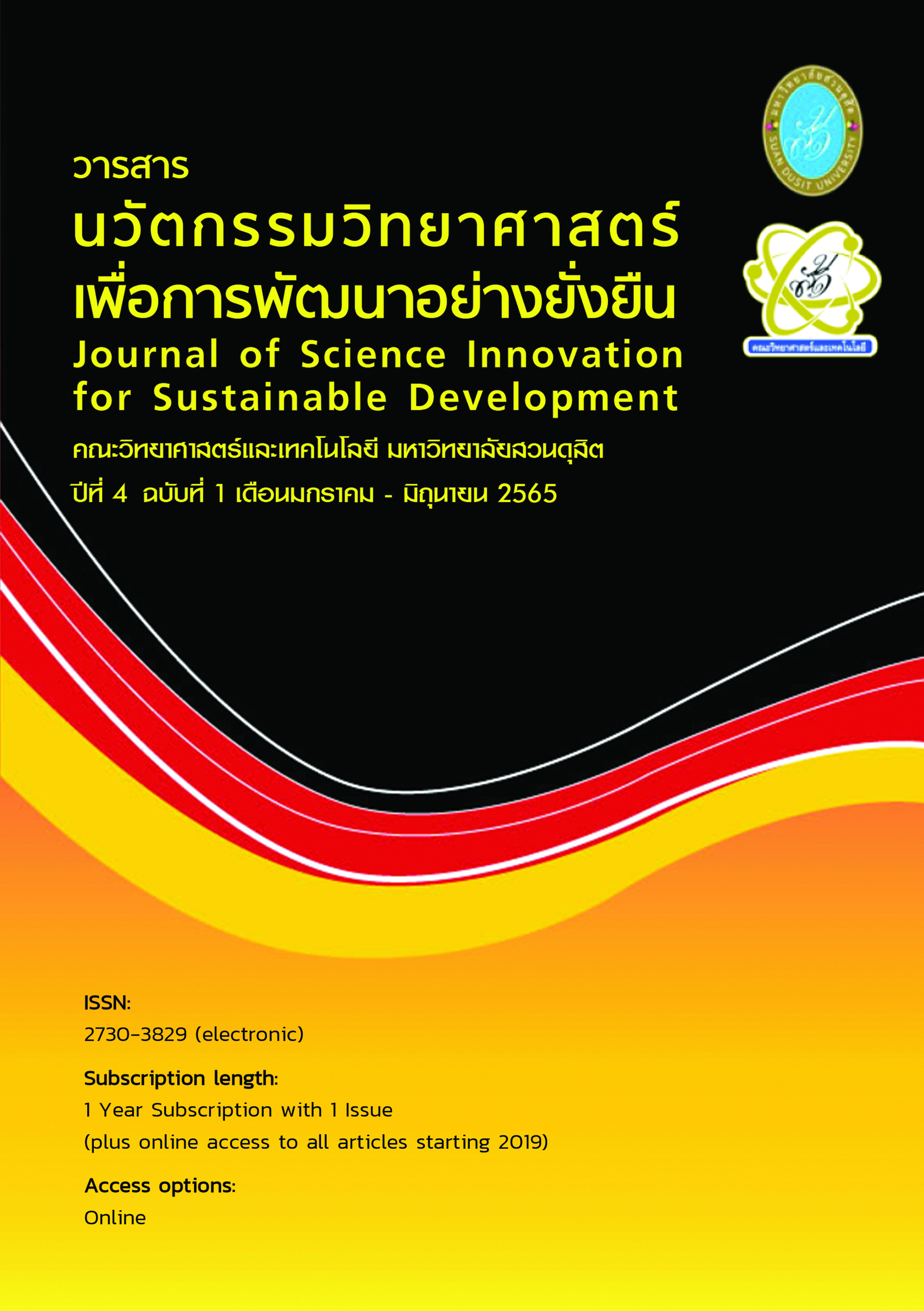การพยากรณ์การเข้าศึกษาต่อของนักศึกษาโดยใช้โครงข่ายประสาทเทียมหลายชั้นแบบแพร่ย้อนกลับ อัญวีณ์ ไชยวชิระกัมพล1,* ศักดิ์ชาญ เหลืองมณีโรจน์1 จีรนันท์ ตะสันเทียะ1 บุญเหลือ นาบำรุง1
Main Article Content
บทคัดย่อ
การวิจัยนี้เป็นการศึกษาและพัฒนาตัวแบบโครงข่ายประสาทเทียมหลายชั้นแบบแพร่ย้อนกลับสำหรับการพยากรณ์การเข้าศึกษาต่อของนักศึกษา ภายใต้ปัจจัยที่มีอิทธิพลต่อการเพิ่มและลดของจำนวนนักศึกษาคณะเกษตรศาสตร์และเทคโนโลยี มหาวิทยาลัยเทคโนโลยีราชมงคลอีสาน วิทยาเขตสุรินทร์ การวิจัยนี้ใช้ข้อมูลประวัติของนักศึกษามาทำการวิเคราะห์คุณลักษณะนักศึกษาแต่ละคนเพื่อสร้างการเรียนรู้ให้กับโมเดล การวิจัยนี้ใช้อัลกอริทึมในการเรียนรู้แบบมีผู้สอนและใช้โปรแกรม WEKA โดยการวิจัยมีการดำเนินการ 2 ขั้นตอน ขั้นแรกวิเคราะห์หาปัจจัยที่เหมาะสมที่ส่งผลต่อการเข้าเรียนของนักศึกษา และ ขั้นที่สอง นำข้อมูลของปัจจัยในขั้นตอนแรกเข้าสู่โมเดลเพื่อสร้างการเรียนรู้ให้แก่โมเดล สำหรับงานวิจัยนี้การเลือกหาโมเดลที่เหมาะสมกับการเรียนรู้ของข้อมูลพิจารณาจากการกำหนดโครงสร้างที่เหมาะสมและให้ค่าความถูกต้องที่ดีที่สุด โดยการวิจัยได้แบ่งข้อมูลออกเป็น 2 ส่วน คือร้อยละ 70 ของข้อมูลใช้สำหรับการสร้างการเรียนรู้ให้กับโมเดล และร้อยละ 30 ของข้อมูลใช้สำหรับการทดสอบโมเดล นอกจากนี้โครงสร้างของโครงข่ายประสาทเทียมหลายชั้นแบบย้อนกลับมีโครงสร้างแบบ 8-19-2 และจำนวนรอบของการเรียนรู้เท่ากับ 500 รอบ ซึ่งผลของการทดสอบกับข้อมูลจำนวน 387 คน พบว่ามีค่า mean absolute error (MAE), root mean square error (RMSE) และค่าความถูกต้องเท่ากับ 0.2179, 0.3696, 82.74 เปอร์เซ็นต์ ตามลำดับ
Article Details

อนุญาตภายใต้เงื่อนไข Creative Commons Attribution-NonCommercial-NoDerivatives 4.0 International License.
ลิขสิทธิ์ต้นฉบับที่ได้รับการตีพิมพ์ในวารสารนวัตกรรมวิทยาศาสตร์เพื่อการพัฒนาอย่างยั่งยืนถือเป็นกรรมสิทธิ์ของคณะวิทยาศาสตร์และเทคโนโลยี มหาวิทยาลัยสวนดุสิต ห้ามผู้ใดนำข้อความทั้งหมดหรือบางส่วนไปพิมพ์ซ้ำ เว้นแต่จะได้รับอนุญาตอย่างเป็นลายลักษณ์อักษรจากคณะวิทยาศาสตร์และเทคโนโลยี มหาวิทยาลัยสวนดุสิต นอกจากนี้ เนื้อหาที่ปรากฎในบทความเป็นความรับผิดชอบของผู้เขียน ทั้งนี้ไม่รวมความผิดพลาดอันเกิดจากเทคนิคการพิมพ์
เอกสารอ้างอิง
Chaiwachiragompol, A. and Suwannata, N. (2016). The features extraction of infants cries by using discrete wavelet transform techniques, international electrical engineering congress. Procedia Computer Science, 86, 285–288. https://doi.org/10.1016/j.procs.2016.05.073.
Intawee, T. (2021). Factors in affecting decision making in selecting educational institutions for higher education. Journal of Educational Innovation and Research. 5(1), 1–14. [In Thai].
Jabjone, S. (2015). Data mining. Nakhon Ratchasima: Faculty of Science and Technology, Nakhon Ratchasima Rajabhat University. [In Thai].
Kaewwijit, T. (2016). The improvement of support vector regression to forecast time series. (Master’s Thesis). Nakhon Ratchasima: Suranaree University of Technology. [In Thai].
Kanjanasamranwong, P., Urawong, K., Mad A Dam, R., and Mad A Dam, S. (2017). The opportunities forecast model in choosing to attend the Prince of Songkhla University of grade 12 students, Songkhla Province. Journal of Education Naresuan University. 19(2), 12–24. [In Thai].
Kijsirikul, B. (2003). Artificial Intelligence. Bangkok: Faculty of Engineering, Chulalongkorn University. [In Thai].
Lorpunmanee, S., Chimphlee, S., Chimphlee, W., Nedtharnn, W. and Piromnok, N. (2019). The forecasting patterns of juvenile recidivism. Journal of Science Innovation for Sustainable Development. 1(1), 80–95. [In Thai].
Ngamlamom, W. (2022). The human resource management of public sector in the disruption era. University of the Thai Chamber of Commerce Journal Humanities and Social Sciences. 42(1), 176–197. [In Thai].
Pacharawongsakda, E. (2014). An Introduction to data mining techniques. Bangkok: Data cube. [In Thai].
PimPa, P. (2018). Current Thai studies. Academic Journal of Mahamakut Buddhist University Roi Et Campus. 7(1), 242–249. [In Thai].
Rahman, H. (2009). Data mining applications for empowering knowledge societies. New York: Information Science Reference. P.12.
Roiger, R. J. and Geatz, M. W. (2003). Data mining: A tutorial-based primer. Boston: Addison Wesley. P.4.
Supabut, P., Hengpraprohm, K., Hengpraprohm, S., and Thammasiri, D. (2015). The comparison of prediction efficiency between linear regression and back-propagation neural network method. joint conference on ACTIS & NCOBA 2015. [In Thai].
Taesombat, S. (1996). Quantitative forecasting techniques. Bangkok: physics-center. [In Thai].
Treepuech, W. (2019). The analysis of injured and dead people data from accident in Songkran Festival by using data mining techniques. VRU Research and Development Journal, Science and Technology. 14(1), 11–20. [In Thai].
Visutthirat, T. (2018). Using data mining in an analysis and model building of the relationship between social quality and happiness of population in chanthaburi province. (Doctoral dissertation). Bangkok: National Institute of Development Administration (NIDA). [In Thai].
Wanon, S. and Muangsan, R. (2020). A study and development of forecasting model for the suitability characteristics on the applying major selection by using data mining techniques. Journal of Management Sciences. 7(1), 135–152. [In Thai].
Winston, P. H. (1992). Artificial Intelligence. Addison-Wesley Publishing Company. (3rd ed.). Massachusetts. US. 443–469.
Witten, I. H. and Frank, E. (2005). Data mining: Practical machine learning tools and technique (2nd ed.). San Francisco: Morgan Kaufmann Publishers. US. P.5.


